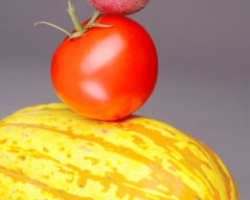· Don’t assume lack of space is a deal-breaker
Most of us don’t live on farms. Nor do we have spacious, magazine-worthy backyards. And in the case of city-dwellers, we may not have backyards of any type! That’s OK. In general, neighborhood gardening novices may start with one of two easy options: the raised-bed garden or the container garden.
A raised-bed garden is one that is built on top of native soil – in other words, one doesn’t have to dig into the yard, it can be built wherever desired. It can be enclosed by lumber, stone, brick, concrete, hay bales, etc., and is filled with the soil of one’s choosing. The advantages include improved accessibility (one need not to stoop as far to reach the plants), good drainage, fewer weeds, the ability to plant more densely, and improved soil quality. Also, raised-bed gardens heat up more quickly than the native soil, so one can plant sooner and probably enjoy a higher produce yield.
As for container gardens, almost any vegetable, and quite a few fruits (such as berries, limes and melons), can be adapted to grow in a pot. So even without a yard, one can still cultivate a container garden on a balcony, patio or windowsill. As with a raised-bed garden, container gardens are very accessible and offer total control over soil quality. Keep in mind a few simple guidelines, such as making sure that larger plants are in larger containers and that all have adequate drainage holes.
· Start small
Biting off more than one can chew can cause a person to become overwhelmed and leave the garden to the not-so-tender mercies of nature. A newbie should choose just a few easy-to-cultivate vegetables, fruits and herbs, preferably ones that already feature prominently in one’s diet. And gradually catch the gardening bug from there.
· Don’t panic about time
Prospective gardeners may be excited by the idea of growing their own fruits and vegetables but daunted by the scope of the project ahead of them. Take a deep breath. After the initial effort of planting and potting is over, the daily garden chores such as watering and weeding will usually be done in 15 to 30 minutes.
· Go easy on yourself
Some types of produce are much hardier to grow than others. Some are easier. Why make the first foray into gardening more difficult than it needs to be by trying to raise plants that are needy? For example, start with tried-and-true plants like basil, rosemary, blueberries, tomatoes, lettuce and peppers, for example.
· Trees are options, too
When most people think gardening, trees don’t necessarily spring to mind. While it’s true that trees can take longer than tomato plants or berry bushes to yield fruit, the wait is usually well worth it. Consider planting cherry, apple, peach, or other fruit-bearing saplings in the yard. As they grow, the trees will be both beautiful and practical. Fruits such as peaches, plums, figs, lemons, limes, etc. (often available in dwarf varieties) can be grown in pots.
· Farm alongside the flowers
Many people whose patios or yards are livened up by colorful flowers have never given a second thought to raising produce. But if one already has the knowledge and skills to care for plants, why not plant some tomatoes or cilantro along with the zinnias and pansies?
· Grow your own spice rack
Many people don’t immediately think of herbs when they hear the word “gardening,” but the truth is that these little plants are generally easy to grow, don’t require much space (think window boxes and small pots) and can really spice up a meal. Plus, with a little advance planning, one can stock the shelf with dried herbs that will last the whole year round.
· Practice pollution-free pest control
It’s a good idea to have a pesticide plan in place. One doesn’t have to risk polluting the yard or harming beneficial insects in the process. For example, hot pepper sprays, garlic, used dishwater and some varieties of plants naturally repel insects and animals alike.
· Make it a group effort
Nobody ever said that gardening had to be a solitary activity. Grab a neighbor or two and share the hoeing, weeding and watering chores. And when the labors bear fruit, share that as well. It’s also worth noting that gardening doesn’t have to be an adults-only activity. It can be a great bonding experience for families, too. Working outside is much healthier than playing a video game or watching TV, and kids will learn quite a bit in the process.
· Make it a community event
There are community gardens springing up in communities all over the place. They may charge a fee for participation and might feature plots that are collectively gardened or plots that are allotted to individuals. There will be an opportunity to take advantage of the expertise of fellow gardeners, and a chance to make some new friends in the process.
· For guidance, find a 4-H club
4-H clubs offers programs to its members that focus on plant science. A local club might be able to give personalized advice on a fledgling gardening endeavor. One might find a fulfilling volunteering or mentoring opportunity in the process.
· Hit up the hardware store
Most hardware stores with gardening centers have everything needed to get started, and that doesn’t simply include plants and gardening implements. Ask employees for advice on everything from which plants grow well in shade to how often to fertilize.
· Make friends at a farmers’ market
Culver City has a farmers’ market on Tuesday afternoons on Main Street. Who better to ask for tips and tricks than fellow citizens who have already learned to garden successfully? This is also a good venue at which to learn about community gardens and group efforts. A goal might be to establish one’s own booth one day soon.













